Tradescantia flowers: a beautiful and unpretentious houseplant
Tradescantia grow wild in the tropics and temperate zones of the United States. The name of the plant was given in the 18th century in honor of the name of the gardener John Tradescant, who brought the plant from Virginia with his son, and then they described it. There are about 70 species in the genus of Tradescantia.
Content:
- Description of the plant
- Reproduction methods
- Houseplant Care Tips
- Diseases and pests
- The healing properties of tradescantia
Description of the plant
Tradescantia has been growing for many years. They have straight or creeping shoots and leaves in the form of ellipses, lancets. Small inflorescences are found in the axils of the leaves that grow on top. In the house, plants are placed in pots.
Types and varieties of tradescantia:
- Tradescantia Anderson. This is a hybrid form. Plants grow in height from 30 to 80 cm and have straight, branched stems. Their leaves are greenish-purple in color. Flowers, umbrella inflorescences can be of different shades: gray, indigo, dawn color, snow-white. Flowers appear from early summer to September. Varieties: "J. G. Weguelin" - it has large light blue flowers; "Osprey" - snow-white flowers; "Iris" - bright blue flowers; "Leonora" - bluish purple flowers; "Purewell Giant" - ruby-colored flowers.
- Tradescantia is white-flowered. Their homeland is the tropics of the southern United States. The plant has ovoid leaves, they are up to 4-6 cm long. The leaves are pointed towards the top. They are emerald or silvery multicolored. The flowers are snow-white. Varieties: "Albovittata" - plants have leaves with white stripes; "Tricolor" - white or lilac-pink stripes on the leaves; "Aurea" - yellow leaves, have emerald stripes; "Aurea Vittata" - golden stripes on the leaves.
- Tradescantia Blossfeld. Grows in Argentina. The leaves grow up to 4-8 cm long, from above they are phthalocyanine green with a slight shade of red, below they are gray. The flowers are white below, purple-pink above.
- Virginia Tradescantia. Grows in the southeast of North America. Flowers are amethyst. Varieties: "Coerulea" - flowers of the color of the sky; "Rubra" - scarlet flowers; "Atro Rubra" - ruby flowers; "Rosea" - pinkish flowers.
- Tradescantia is pale. It is a little poisonous and if the juice gets on the skin, it can become inflamed. The plant has long shoots (1 m), the leaves give off a bluish, a little fluff from the bottom of the leaves. Small pink flowers.
- Tradescantia is zebra-like. It has reddish dangling, bare shoots. Leaves 8-10 cm, they are emerald on top, have 2 white-silver stripes. Below the leaves have a carmine shade. Flowers are medium-sized crimson or bluish hue.
- Tradescantia is scaphoid. Grows in Mexico and Peru. These plants have creeping bare shoots and ovoid leaves, on which purple dots are visible. Their flowers are pink.
- River Tradescantia. It grows exclusively in Brazil. Has creeping shoots of a purple hue with greenish spots. The leaves are dark emerald above and purple-scarlet below.
- Sillamontana Tradescantia. Has white felt all over it to keep the water from evaporating. In dim light, the felt thins. The stems are straight, the leaves are arranged in a spiral. Grows in northeastern Mexico.
- Tradescantia is thick. She loves moisture very much.Has thickened and long leaves (6-15 cm), a border is visible along their edges.
- Tradescantia is hairy. She has straight stems and long leaves that have white pubescence. The flowers are pinkish lilac.
- Tradescantia is colorful. She has medium-sized green leaves, on which there are white or pinkish stripes.
Reproduction methods
Seeds Tradescantia is sown in mini greenhouses in March. For the substrate, take 1 part of peat land and 1 part of sand. Between the sown seeds, an indent of 1–2 cm is made, a distance of 12–15 cm is observed between the rows. After that, the seeds are sprinkled with soil by 1 cm. The temperature should be + 20 ° C. The mini greenhouse is periodically sprayed and ventilated. Seeds germinate for a long time, more than 1 month. Saplings begin to bloom at 3 years old.
If you want to propagate a bush by dividing the bushes, then do it in early spring. When you remove the bush, do it very carefully, being careful not to damage the rhizomes. A large bush can be divided into several parts. Then dry the cuttings for 10-15 days before planting.
For propagation by cuttings, shoots are cut into cuttings 10-15 cm long.
Make a substrate from 1 part compost, 1 part humus and 1 part sand. His disinfect, warming up in the oven, after planting cuttings, while placing 5-10 cuttings in a pot. In a week, at an air temperature of + 10-20 ° C, tradescantia will give roots. The best acidic soil characteristics are pH 5-5.5. ...
Houseplant Care Tips
Tradescantia likes bright, diffused light most of all, although it can grow in partial shade. It is best to put it on windowsills located in the east or west. In plants, shoots are stretched out from a lack of light, and the leaves grow close to each other, and the leaves also become not decorative and faded. Variegated species require more bright light, as their leaves turn emerald in the shade and the stripes are not visible. If the direct sunlight is too bright, the leaves burn out. The white-flowered Tradescantia shade is best tolerated. In summer, Tradescantia can be displayed on the loggia or planted in the garden.
Tradescantia prefers to grow in rooms with a temperature of 25 ° C in summer and 8-12 ° C in winter.
Plant care features:
- Watering... Tradescantia needs to be watered thoroughly and intensively in spring and summer, but moisture should not stagnate. Water it after 1-2 days, when the top of the soil dries up. In winter, watered in 2-3 days. It is constantly required to watch so that water does not accumulate in the pan. After 30 min. after watering, it is required to drain the water from the pallet, and wipe the pallet itself with a cloth. Always watered with soft and well-settled water. Plants should be sprayed constantly, especially in summer. In winter, if the plant is in a room with a temperature of + 12-16 ° C, then it is much less frequent, otherwise root rot may appear.
- Fertilizer. Top dressing is applied in spring and summer 2 times a month. Tradescantia, which have variegated leaves, should not be fertilized organicas the leaves may turn green. For feeding, they buy complex mineral fertilizers for decorative deciduous plants. During the rest of the year, plants are not fertilized.
- Transfer... An annual plant is transplanted 1 time in the spring, adult plants every 2-3 years. For transplantation, a substrate is made of humus, which has neutral characteristics (pH 5.5-6.5). You can also make soil from 1 part sod land, 2 parts deciduous soil and 1 part humus, and add some sand there. You can buy special soil for tradescantia in the store. At the bottom of the pot, drainage is made from broken brick or small rubble.
- Pruning. When the plants are transplanted, those shoots that are more than 1 year old are cut at the same time. Leave stems 3-5 cm long. You can still pinch too long shoots.
Diseases and pests
Diseases in Tradescantia arise for reasons of improper care of it.With her appearance, she can tell the florist what is wrong and what needs to be done:
- If the stems of the tradescantia are stretched out and the trunk is bare, then this is from a lack of water, lighting and top dressing.
- In variegated forms, the leaves may simply turn green from lack of light.
- If the stems became lethargic, and yellowish spots appeared on the leaves, this was due to a lack of water.
- In winter, the stems of tradescantia can stretch out and dry out the leaves, then you can update the plants by propagating them cuttings.
- The tips of the leaves turn brown from too dry indoor air.
Tradescantia may be attacked aphid, scale insects, thrips, spider mites. To eliminate pests, the plant is sprayed with insecticide solutions.
When the scabbards attack, they wipe the tradescantia with a cotton swab dipped in water and soap. This is done about 4 times a week. If there are a lot of scale insects, then they are sprayed with Aktellik, Fufanon or Karbofos. Can be sprayed with folk remedies - infusion pyrethrum or garlic.
When aphids are affected, the foliage changes color and dries up, and the shoots curl.
Aphids leave a sticky discharge on which a sooty fungus develops. Aphids are eliminated by spraying the flower with a solution of laundry soap or washing powder. With a large accumulation of aphids, the plant is treated with Aktellik or Karbofos. Folk remedies for the elimination of aphids: 1.5 tbsp. finely chop the tablespoons of dandelion leaves, pour half a liter of water at a temperature of 50 ° C. Treat with the composition every week. To destroy the spider mite, use a solution of Karbofos or Fitoverma.
Tradescantia is not resistant to rot. A plant affected by root rot needs to be transplanted into another soil. If most of its roots are damaged, then they throw it away, before that, cutting off healthy shoots and cutting them into cuttings. If mold formed on the tradescantia in winter, and then they rotted, then this disease is called mycosis. It occurs when there is too much humidity, with a lack of ventilation. Spray the plants with mycosis fungicides.
The healing properties of tradescantia
Jonathan Pirero found in Tradescantia Zebrin juice an element similar in action to insulin, it lowers blood sugar. In addition, there are phytoncides in Tradescantia, which destroy microbes and most viruses. Plants are best used to treat stomach and intestinal ailments. The plant sap is used to treat bronchopulmonary diseases.
It is advised to apply the leaves of Tradescantia Zebra to the skin for wounds and scratches. After that, tie the leaves with a gauze bandage. The leaves are used for boils. Squeeze the juice from the plant, pour the warm juice onto a gauze swab and apply to boils and boils for 30 minutes, then bandage with a bandage. Change the bandage 5-6 times a day.
Tradescantia purifies the air from harmful impurities and humidifies it.
In case of diseases of the stomach and intestines, drink a 30% tincture of the plant, diluting it with boiled water at a rate of 1: 2 (100 ml of tincture and 200 ml of boiled water). For flatulence, finely chop 1 tbsp. spoon of leaves, pour them into a glass of boiling water, pour into a thermos and leave for 2 hours, then strain. Drink 1/3 cup, preheated, three times a day, half an hour before meals. At the same time, eat only dietary foods. Pass the tradescantia leaves through a meat grinder and apply the gruel to the wounds.
For diarrhea, chop 3 tablespoons finely. tablespoons of leaves, place in a glass of boiling water, leave for 2 hours, strain. Drink half a glass twice a day 30 minutes before eating, warm up the infusion each time. Follow your diet.
More information can be found in the video:




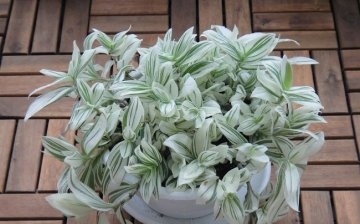
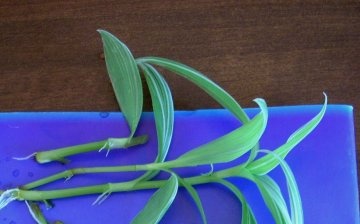
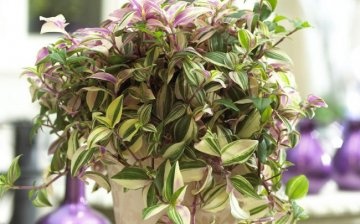

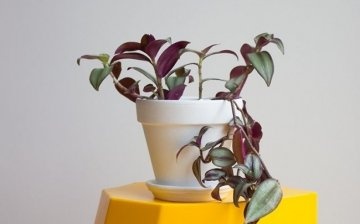






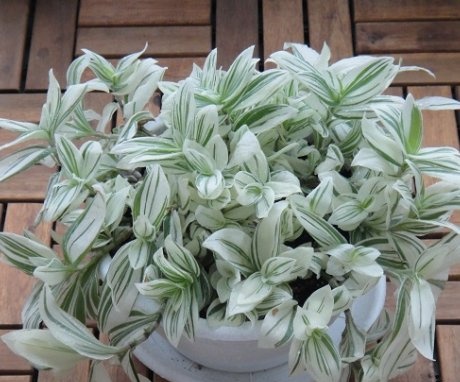
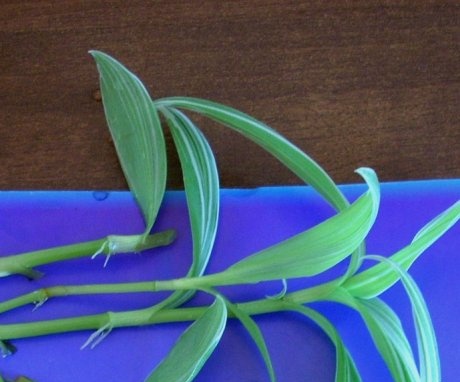
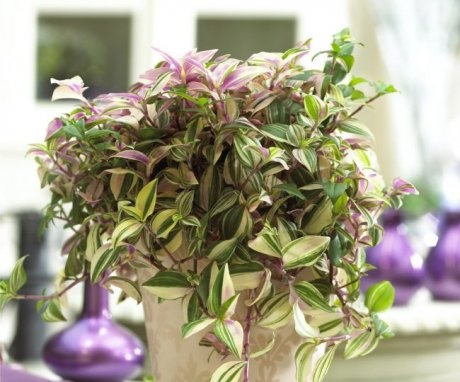

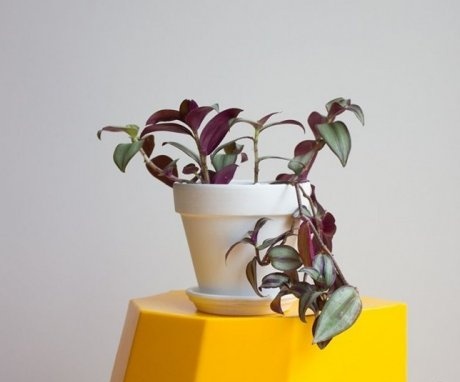
I had a tradescantia with purple, velvety leaves. It was green, solid and with white streaks.All its types do not require special care, they grow very quickly. I broke off the branches and handed them out to everyone who wanted to know.